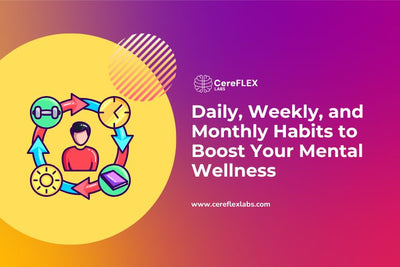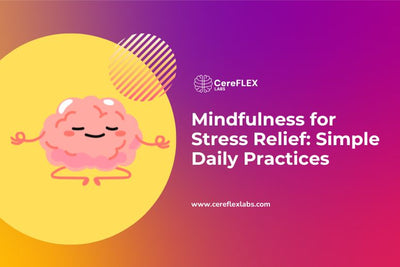A migraine isn’t just a headache—it’s a full-body disruption. For many, it begins with flashing lights or a stiff neck, followed by nausea, mood swings, and hours of throbbing pain.
While common triggers like stress, hormone changes, or skipped meals get much of the blame, the real drivers lie deeper—in your brain’s chemistry. Specifically, neurotransmitters.
These microscopic messengers affect how your brain handles light, sound, hunger, emotions, and pain. During a migraine, this delicate chemical balance collapses. Serotonin levels crash. CGRP surges. Dopamine misfires. Glutamate overstimulates. GABA, your brain’s calming force, fades into the background.
This isn’t random chaos—it’s a chain reaction. Neurotransmitter shifts activate your trigeminal nerve, the brain’s key pain pathway. As inflammation builds and blood vessels widen, your brain becomes hypersensitive to even mild sensory input.
This guide explains how each major neurotransmitter plays a role in migraines—and what you can do about it.

The Brain Chemistry of Migraines
Migraines don’t appear out of nowhere—they begin quietly in the brain, often days before symptoms hit. At the root are neurotransmitters: chemical messengers that help nerve cells talk to each other.
These messengers control how you feel pain, react to light or sound, regulate blood flow, and manage stress. When neurotransmitters are balanced, the brain runs smoothly. But small chemical shifts can set off a migraine.
One key event is called cortical spreading depression (CSD). This is a slow wave of reduced activity across the brain’s outer layer. As it spreads, it can activate the trigeminal nerve—the brain’s main pain pathway.1
Once activated, the trigeminal nerve becomes overly sensitive. Mild sensations like light, sound, or motion can feel overwhelming.
This reaction doesn’t happen on its own. Daily habits and stressors shape the brain’s chemistry.
For example, stress can drain serotonin. Poor sleep may lower GABA and raise glutamate, making the brain hyperactive. Certain foods—especially those high in tyramine or caffeine—can affect dopamine and norepinephrine levels.
Hormonal changes also play a role. Estrogen fluctuations, particularly before a menstrual period, can alter serotonin and GABA balance. This helps explain why migraines are more common among women.

Serotonin & Migraine: A Complicated Relationship
For years, researchers believed low serotonin was the main cause of migraines. This idea made sense—serotonin helps regulate pain, and low levels are also linked to depression, a common comorbidity in people with migraines.
But recent research has challenged this view.
A PET imaging study found lower binding of 5-HT4 receptors in migraine patients.2 This suggests their brain serotonin levels may actually be higher between attacks. This raises new questions: Is high serotonin a trait of the migraine brain? Or a rebound effect after recent pain episodes?
Despite the uncertainties, serotonin still plays a central role during migraine attacks.
Triptans, the most widely used migraine medications, target 5-HT1B and 5-HT1D receptors. These drugs help relieve symptoms by constricting blood vessels and calming nerve pathways.
However, because of their vasoconstrictive action, triptans may not be safe for people with certain heart conditions.

Dopamine’s Role in Migraine
Dopamine may play a key role in certain types of migraines. Although dopamine levels tend to stay steady between attacks, they often drop right before or during a migraine.
This drop can trigger early warning signs like:
- Yawning
- Nausea
- Fatigue
- Mood changes
- Low blood pressure
These symptoms, known as the prodrome and postdrome phases, point to heightened dopamine receptor sensitivity.
Research shows that people with migraines often react strongly to dopamine-related medications. They’re more likely to experience dizziness, low blood pressure, and changes in cerebral blood flow—signs of dopaminergic hypersensitivity.
Hormonal and brain imaging studies also show irregularities. These include altered prolactin responses and increased D5 dopamine receptor activity. Together, these findings suggest dopamine dysfunction may be a defining trait in some migraine subtypes.3
There’s also a clear overlap between migraines and dopamine-related conditions like depression, ADHD, Parkinson’s disease, and tic disorders. This connection strengthens the case for dopamine as a target in future migraine treatments.
Glutamate & GABA: The Seesaw Behind Migraine Sensitivity
Glutamate and GABA are two of the brain’s most powerful chemical messengers. They act like a seesaw—glutamate excites, while GABA calms.
In people with migraines, this balance often tips too far in one direction.
Too much glutamate can overstimulate nerve cells, lowering the brain’s pain threshold and triggering symptoms like visual auras. On the flip side, not enough GABA means fewer calming signals, leaving the brain vulnerable to sensory overload.
This imbalance may help explain why migraine brains are more excitable and reactive.
Studies suggest that boosting GABA activity could help prevent migraines without aura. Meanwhile, treatments that block glutamate pathways—especially the NMDA receptor—may be more effective for migraines with aura.4
By regulating this glutamate-GABA balance, future therapies could reduce the brain’s tendency to overreact and help keep migraines at bay.
Calcitonin Gene-Related Peptide (CGRP) and Migraine
CGRP is a neuropeptide that plays a central role in the pain and inflammation associated with migraines. It’s released by trigeminal nerve cells—especially when the body mimics inflammatory conditions.
Once CGRP is released, it causes nearby blood vessels to widen (vasodilation) and prompts the release of proinflammatory chemicals. This creates a feedback loop that keeps CGRP levels elevated and prolongs the migraine.5
The result? Ongoing pain, longer attacks, and a more sensitive trigeminal nerve system.
Migraine treatments like sumatriptan reduce both the release and production of CGRP. This has led to the development of CGRP inhibitors—newer drugs that directly block this peptide’s effects.
These medications offer another path to migraine relief, especially for people who don’t respond well to traditional options.
Adenosine and the Caffeine Connection
denosine is a natural brain chemical that slows down activity. It promotes rest, dilates blood vessels, and contributes to feelings of fatigue.
During a migraine, adenosine levels rise. This can lead to drowsiness, head pressure, and worsening pain. In fact, studies show that injecting adenosine can trigger a migraine in sensitive individuals.
Caffeine works by blocking adenosine receptors in the brain. That’s why it helps reduce fatigue, increase alertness, and constrict blood vessels that may have expanded during a migraine.
Because of these effects, caffeine is included in many over-the-counter migraine treatments.
But it’s not a perfect fix. Using caffeine too often can backfire. Your brain adapts, and stopping suddenly may lead to rebound headaches. For sensitive individuals, daily use can cause more problems than it solves.
A better approach? Use caffeine strategically at the start of an attack—and explore caffeine‑free nootropics if you’re prone to overstimulation.

Estrogen’s Role in Migraine
Estrogen has a powerful effect on brain chemistry—and it’s closely tied to migraines, especially in women.
Many people experience migraines around their menstrual cycle. A review of 19 studies confirms this link, showing that estrogen fluctuations play a significant role.
The leading theory suggests that a sharp drop in estrogen—especially after a sustained high level—can trigger a migraine. For many women, this occurs just before menstruation, when estrogen dips below 45–50 pg/mL.
Women with a history of migraines seem especially sensitive to these hormonal changes. It’s not just the absolute level of estrogen, but how fast it rises or falls that matters.
While estrogen is a key factor, its effects vary by age, hormone use, and overall health. More research is needed—particularly in comparing menstruating and postmenopausal women—to understand how hormonal changes affect different groups.6
How Lifestyle Triggers Tie in
Your brain doesn’t function in a vacuum. Everyday habits—how you sleep, eat, manage stress, or process your environment—can tip your brain chemistry toward a migraine.
If you’re genetically prone, even small changes in routine can trigger a chain reaction.

Stress
When you’re under stress, your brain produces more norepinephrine and less serotonin. This chemical shift lowers pain tolerance and increases sensitivity, raising your risk of a migraine attack.
Lack of Sleep
Poor sleep affects neurotransmitter balance. Glutamate levels rise while GABA levels fall—creating a hyperexcitable state. This makes you more sensitive to light, noise, and movement.
Diet and Dehydration
Skipping meals or eating foods high in tyramine—like aged cheese or processed meat—can lower serotonin and activate stress pathways. Dehydration or caffeine withdrawal also impact blood flow and neurotransmitter balance.
Sensory Overload
A brain already on edge can’t handle bright lights, loud noises, or strong smells. These otherwise harmless stimuli can become overwhelming when neurotransmitters are off balance.
Genetics
Some people have more sensitive dopamine or serotonin receptors due to genetic variation. This means common triggers—like hunger or a bad night’s sleep—can lead to full-blown migraines more easily.
Mitigation Strategies: What You Can Do
Understanding your brain chemistry is the first step. The next is putting that knowledge to work.
You can’t control every trigger—but you can reduce how often migraines occur and how severe they get by making simple, consistent changes.

Sleep Regularly
Go to bed and wake up at the same time each day. Consistent sleep helps stabilize neurotransmitters like serotonin and GABA.
Exercise Moderately
Regular movement boosts serotonin, endorphins, and brain-derived neurotrophic factor (BDNF). Just don’t overdo it—light aerobic exercise is enough when you're feeling vulnerable. For a gentle mental lift, consider best nootropics for energy and focus.
Reduce Stress
Use techniques like deep breathing, mindfulness, or CBT to lower cortisol and protect your brain’s chemical balance. You might also try nootropics for motivation and focus to support mental clarity.
Avoid Tyramine-Rich Foods
Watch out for aged cheese, red wine, cured meats, and fermented foods. These can trigger migraines by interacting with the adrenergic system.
Support GABA Naturally
Here are practical ways to increase GABA:
- Exercise regularly: Try 30 minutes of cardio four times a week.
- Meditate: Even 5–10 minutes of mindful breathing can help.
- Try yoga: Movement + breathwork = more GABA, less anxiety.
- Eat GABA-rich foods: Spinach, lentils, bananas, yogurt, and nuts.
- Avoid junk food: Processed foods can spike blood sugar and affect mood.
- Limit alcohol: It reduces natural GABA production.
-
Explore supplements: Magnesium, green tea, B6, zinc, and taurine may help. Always consult a healthcare provider first.
Use Adaptogens
Adaptogens like ashwagandha, rhodiola, and holy basil help regulate cortisol and may support stable levels of serotonin, dopamine, and GABA. They’re especially useful if your migraines are triggered by burnout, anxiety, or lack of sleep.
Be sure to check with your healthcare provider before using them—especially if you’re taking medication.
Test and Target Your Migraine Triggers
Neurotransmitter testing can reveal imbalances in serotonin, dopamine, GABA, and more. For women, hormonal testing may explain menstrual migraine patterns.
With the right data, a practitioner can help you go beyond symptom management and target the root causes of your migraine chemistry.
Conclusion
Migraines aren’t random—they’re the result of complex chemical shifts in the brain. Triggers like stress, missed meals, poor sleep, or hormone changes can disrupt neurotransmitters like serotonin, dopamine, GABA, and CGRP, setting off pain, nausea, and sensory overload.
The good news? You’re not powerless.
By understanding how these brain chemicals behave, you can make informed choices—like improving sleep, adjusting your diet, managing stress, and exploring tailored supplements. These changes don’t just help with symptoms—they address what’s happening at the source.
At CereFLEX Labs, brain health is at the heart of what we do. Our AM/PM Brain Protocol is designed to align with your natural rhythms—supporting mental energy and focus during the day, and promoting calm, restorative recovery at night.
If you’re ready to stabilize mood, sharpen focus, support circulation, or protect your brain from daily stressors, visit cereflexlabs.com to find a smarter, science-backed way to reduce migraine risk and support long-term cognitive wellness.






